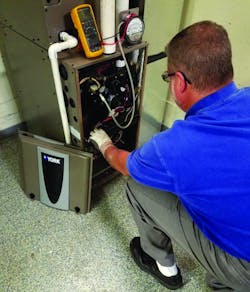Fall is here, and that means service technicians will be performing annual maintenance and checkup on HVAC systems. The annual checkup of heating systems reduces the likelihood of a malfunction occurring when people depend on the equipment the most. Maintaining equipment to prevent future problems and unwanted costs is critical. If the heating equipment breaks down anytime during the winter, a homeowner can end up paying substantially more in terms of inconvenience and for the cost of emergency repairs.
First things first. Modern day furnaces have many more safeties than standing pilot models, but service technicians should always remember they are working on a gas appliance that can harm or potentially kill someone if not installed or operating properly. They must always be very observant of the installation and operation of a heating system. If a catastrophic event were to occur involving the product and the service technician or one of their employees were the last one to service the equipment, their company could be held liable. Service and installation should always be performed by licensed mechanical technicians. Furnaces that are well maintained should provide many years of service without unexpected breakdowns.
A typical preventive maintenance furnace service call should consist of the following steps:
1. Remove flame sensor, ignitor, burners, hoses, etc.
2. Wipe the entire cabinet down on the inside and out.
3. Vacuum debris from the cabinet.
4. Inspect/and or replace the air filter.
5. Wash out/flush all condensate hoses, traps, etc., if applicable.
6. Inspect pressure switch hoses and replace if hoses are brittle.
7. Clean flame sensor with 0000 fine steel wool. DO NOT use emery cloth. The sensor is a Kanthal rod. Cleaning the sensor with emery cloth will leave silica embedded in the rod which in turns acts as an insulator. Emery cloth or sandpaper can also leave scratches in the flame rod which will cause it to get dirty quicker and lead to premature failure.
8. If the furnace has a spark ignitor, clean it with fine steel wool as well.
9. Inspect the furnace hot surface ignitor. You can ohm out the sensor if necessary when it is at room temperature. Our silicon carbide ignitors should ohm out at 40 - 400 ohms. Our silicon nitride ignitors should read 40 - 70 ohms.
10. Thoroughly clean each burner by using a wire brush. Blow each burner out with high-pressure air.
11. Test indoor fan motor run capacitor if applicable.
12. Inspect indoor fan blower wheel for dirt/debris. If dirty, remove and wash.
13. Inspect furnace vent piping to make sure all joints are properly connected. Make sure there are no sags in the vent piping. Check the vent termination and make sure it is clean and properly installed.
14. Visually inspect the heat exchanger assembly for signs of soot, rust or cracks in the exterior walls. Clean or replace as necessary.
15. Reassemble the furnace and check for proper operation.
16. Check manifold gas pressure and temperature rise. See unit rating plate for appropriate settings.
17. A combustion analyzer is a great tool to check for proper combustion.
Properly maintained systems can help save money and protect customers. Improper operating gas appliances are a fire hazard and could contribute to health problems. Only licensed, insured and professional technicians should inspect and service a heating system to identify any potential deficiencies and make any necessary repairs before it becomes more costly to repair.
A clean, well-maintained furnace will provide years of safe reliable heating for a home.
Kenny T. Bui is MGLM, LSSMBBP, product manager, Unitary Products Group, Johnson Controls.
Casey McConnaughy is field service supervisor, Unitary Products Group, Johnson Controls
Mark Freund is senior manager, field service, Unitary Products Group, Johnson Controls.
